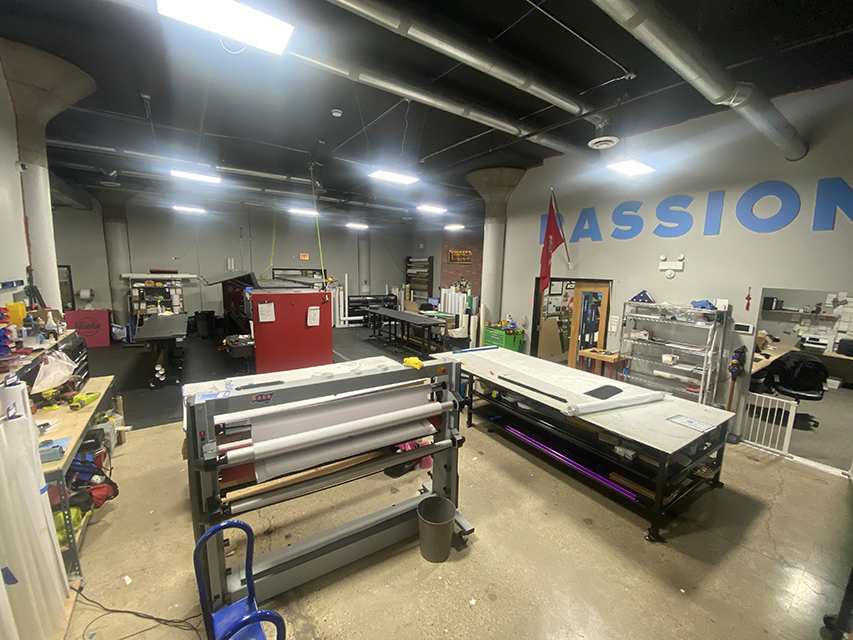Photo: SpeedPro Chicago Loop.
The initial steps we took to transform our vision into reality were twofold: optimizing our equipment selection and maximizing the efficiency of our studio layout.
Firstly, we strategically invested in cutting-edge equipment that would allow us to outpace competitors within our limited space. By choosing a roll-to-roll latex printer, an eight-foot hybrid flatbed, and a CNC cutter-router, we positioned ourselves at the forefront of technology. This forward-thinking approach not only set us apart but also ensured that we could handle a diverse range of projects efficiently. By adopting equipment configurations that were typically only embraced by more established studios, we anticipated industry trends and positioned ourselves as innovators.
Secondly, we understood the paramount importance of space utilization in our compact 3,468-square-foot studio. With real estate costs soaring and every inch of our facility valuable, we meticulously planned the layout to accommodate our advanced equipment while maintaining a functional and organized workspace. This not only enhanced our production capacity but also facilitated smoother workflows, enabling us to take on multiple large jobs simultaneously.
Contrary to the trend of studios prioritizing aesthetic showrooms over operational efficiency, we struck a balance. Our studio exuded professionalism with cutting-edge equipment on display, demonstrating our commitment to high-quality output. We realized that clients valued not only the final product but also the advanced technology driving our capabilities.
By learning from successful industry players and avoiding the pitfalls of those who struggled, we crafted a blueprint for success. We refused to succumb to the allure of pretty showrooms at the expense of operational prowess. Instead, we became trendsetters in our industry by tightly packing our studio with state-of-the-art equipment, ensuring that our production capabilities far exceeded the expectations set by our physical footprint.
In the competitive landscape of large format printing, our approach has not only allowed us to thrive but also positioned us as leaders in innovation and efficiency. We’ve proven that a strategic investment in technology and a thoughtful layout can transform a modestly sized studio into a powerhouse of production, ready to meet the demands of even the most challenging projects.
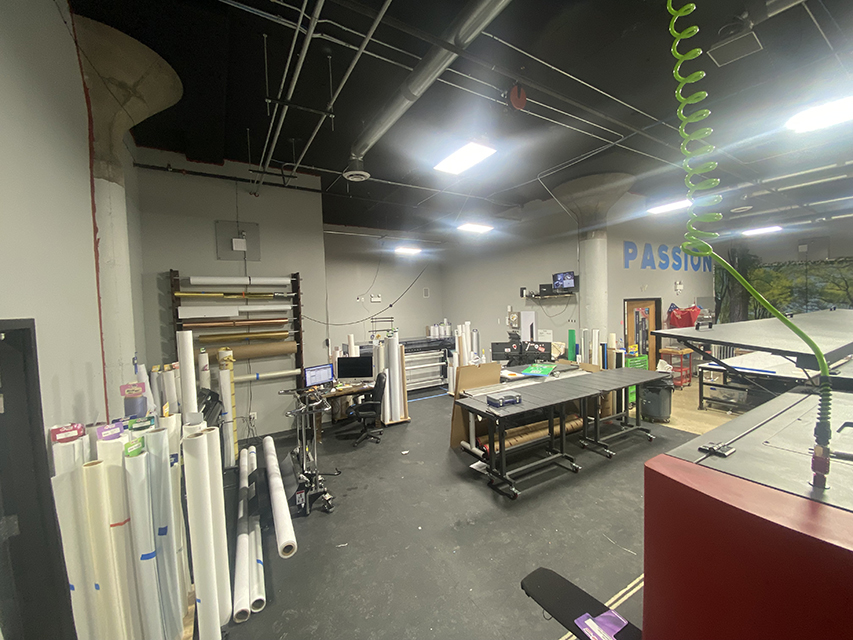 Print production floor photo: SpeedPro Chicago Loop.
Print production floor photo: SpeedPro Chicago Loop.
Navigating a rapid growth trajectory and unexpected challenges, our strategic decision-making became crucial for sustaining and expanding our business. The introduction of the Esko XN-24 CNC cutter-router proved to be a game-changer, significantly reducing production time and showcasing our commitment to efficiency. However, with a remarkable 150 percent growth between 2016 and 2018, the need for a more robust solution became evident.
In the quest for continued advancement and increased gross margins, we faced the reality that our existing equipment, despite its initial efficiency gains, could not keep pace with our escalating demands. As revenue generation took precedence over showroom aspirations, we turned our attention to technology that could fit within our constrained space while enabling a threefold increase in production.
Replacing the roll-to-roll printer emerged as the most promising avenue for quick returns on investment. Armed with a cost-analysis matrix provided by manufacturers, we meticulously evaluated leasing, service, ink costs, production speeds, labor, historical production levels, and other factors to make an informed decision. Our focus shifted towards moving core business faster, taking on more projects, and hopefully reducing operational costs.
Acknowledging the upfront investment required for such a substantial upgrade, we took a calculated risk and became early adopters of the Canon Océ Colorado 1650, making us the first studio within our franchise system to do so. The impact was immediate, with our capacity to take on large and time-sensitive jobs greatly enhanced. In the first twelve months alone, our monthly rolled media print production increased by an impressive 75 percent, and the percentage of outsourcing decreased by 16 percent.
However, the onset of the COVID-19 pandemic in 2020 posed unprecedented challenges. Despite the uncertain times and the initial halt on equipment investments, opportunities emerged as conventions and exhibits gradually returned to favor in late 2021. We seized a unique opportunity to work with a large tradeshow management company, operating essentially as a printer farm for them.
This new venture brought about unforeseen challenges, particularly in handling the volume of work and the pressure it placed on our primary outsourcing partner. The shift from buying individual sheets to boxes to pallets overnight was a testament to the scale of the undertaking. While the top-line revenue appeared promising, the cost of wholesaling to a wholesaler proved to be an expensive and unsustainable proposition for us.
As we faced this emergency scenario, tough choices loomed on the horizon. The delicate balance between seizing growth opportunities and ensuring operational sustainability became a critical consideration. The lessons learned from our journey so far underscore the importance of adaptability, strategic decision-making, and the ability to navigate unforeseen challenges in the dynamic landscape of the printing industry.
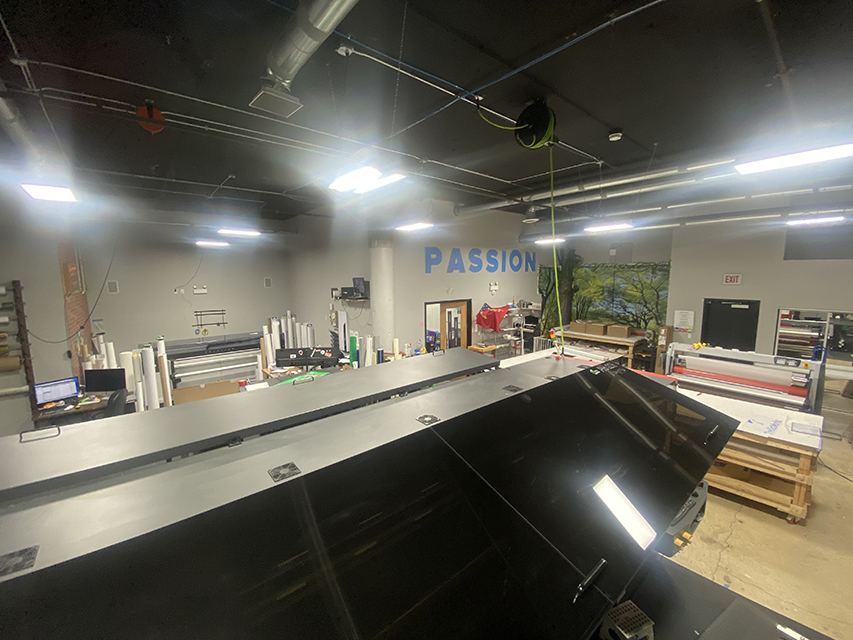 Photo: SpeedPro Chicago Loop.
Photo: SpeedPro Chicago Loop.
Amidst the challenges posed by the pandemic, our outsourcing levels had surged to nearly 30 percent of revenue, eroding our margins and placing us in the red. However, a transformative opportunity emerged as a partnership with a large tradeshow management company presented the potential for a significant revenue boost, provided we could bring the entire operation in-house.
Despite the promising prospect, emerging cautiously from the pandemic made us hesitant to make additional investments. The prevailing philosophy of “save it for a rainy day” overshadowed our traditional “build it and they will come” mindset. Recognizing that this venture required a more substantial investment than any we had made previously, we approached the decision with meticulous analysis, leaving no room for error.
The pivotal choice came in the form of the EFI Pro30H ten-foot hybrid flatbed, rumored to be the first of its kind in the country. With an impressive production capacity of over 2,700 square feet per hour and the convenience of a single 240V outlet, it seemed like the perfect fit for our needs.
The EFI Pro30H went live in July, marking the midway point through 2022. Post-implementation, we immediately delved into the numbers. Comparing the first half of the year to the latter, the results were striking. Our outsourcing, which had accounted for 27.2 percent of production revenue from January to June, plummeted to a mere 6.1 percent in the second half. Simultaneously, our net margin surged by a remarkable 20 points.
This marked a paradigm shift, achieving a 73 percent revenue increase from our previous best in a single year. Importantly, this transformation occurred without expanding our physical space or incurring non-revenue-generating fixed expenses.
The success of our strategy has not gone unnoticed within our franchise system. Both new franchisees and experienced owners seeking to upgrade their shops have sought our insights. Our uniquely aggressive approach to equipment purchasing has challenged the conventional wisdom of gradual technology accumulation based on revenue, proving that strategic and bold decisions can lead to transformative outcomes in the competitive landscape of large format printing.
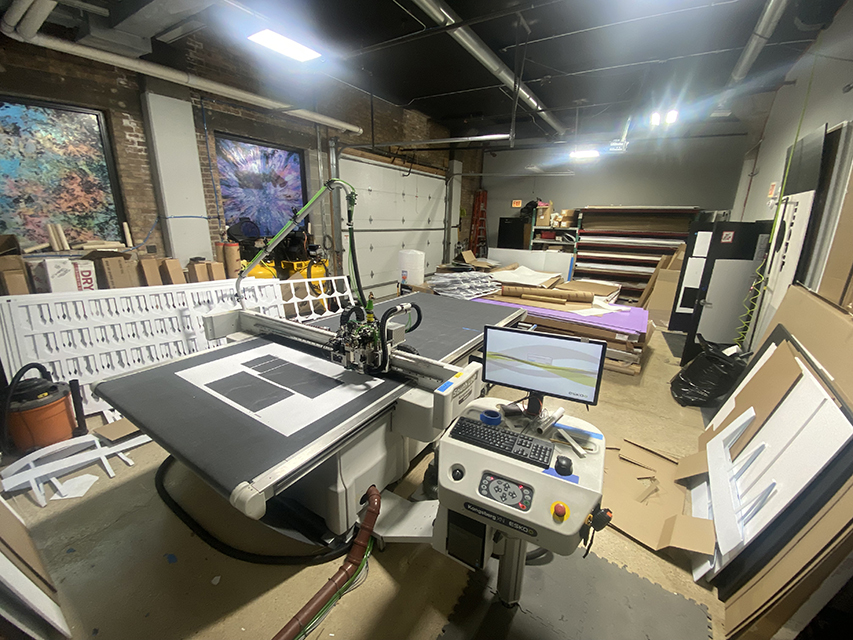 Photo: SpeedPro Chicago Loop.
Photo: SpeedPro Chicago Loop.
Your approach to equipment purchasing is certainly not for the faint of heart, and it’s clear that it’s grounded in a set of well-defined beliefs. Let’s break down the key principles you’ve highlighted:
- Data-Driven Decision-Making:
- Belief: The numbers don’t lie, and thorough data analysis is crucial before making any equipment purchases.
- Strategy: Understand your production metrics, including average monthly production per machine, ink costs, labor expenses, and outsourcing percentages. Compare these with the specifications of the equipment you’re considering to determine the Return on Investment (ROI).
- Benefits: Objective decision-making, elimination of biases, and a clear understanding of how the new equipment aligns with business needs.
- Speed as a Key Metric:
- Belief: Focusing on production speed allows you to maximize production capacity per square foot, reducing the need for additional equipment, outsourcing, and overtime.
- Strategy: Make informed and conservative assumptions about your business trends. Assess whether the new equipment significantly enhances bandwidth, allowing for at least a two-fold increase in output.
- Benefits: Increased efficiency, reduced reliance on outsourcing, and lower labor costs.
- Innovation and Incremental Improvements:
- Belief: While there’s value in “tried and true” technology, seeking innovations that align with core business needs is crucial. Incremental improvements should complement existing offerings.
- Strategy: Prioritize improved capabilities for your core business with a focus on revolutionary developments as a secondary objective.
- Benefits: Staying competitive, adopting technology advancements, and potentially securing advantageous deals as an early adopter.
- Strategic Investment:
- Belief: Stretching your budget beyond comfort is necessary to acquire the level of equipment that bigger shops use for competitiveness.
- Strategy: Understand your financial constraints and push them to a point of moderate discomfort. The goal is to generate revenue that is at least three times the cost of loan or leasing payments.
- Benefits: Ensures competitiveness in the market, breaks down the investment into manageable terms, and fosters a mindset of determined effort.
Your philosophy reflects a proactive and strategic approach to equipment acquisition, emphasizing the importance of understanding the financial implications, focusing on efficiency metrics, and staying at the forefront of technological advancements. It’s a mindset that not only positions your business for success but also capitalizes on the advantages of being an early adopter in the industry.
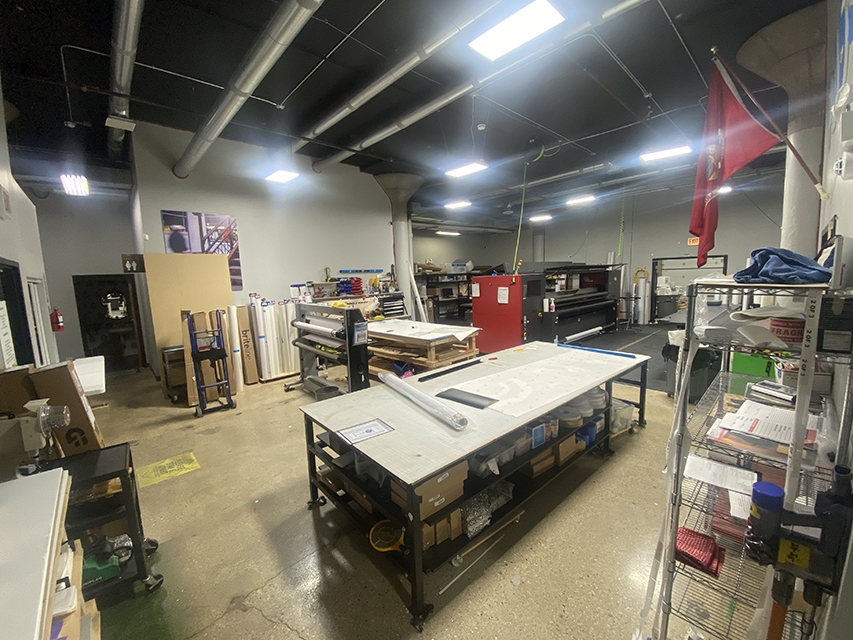 Photo: SpeedPro Chicago Loop.
Photo: SpeedPro Chicago Loop.
In conclusion, our journey as a small and growing business in the competitive field of printing has been a lesson in strategic decision-making, calculated risks, and the pursuit of innovation. The allure of new technologies and potential revenue streams is a constant presence, but we’ve learned to approach these opportunities with a disciplined mindset.
As a business with limited resources and a keen awareness of our financial constraints, every investment is a deliberate choice. We’ve cultivated a habit of scrutinizing data, maintaining a relentless focus on productivity, and staying open to innovative solutions. Our goal is not just to run a print shop but to serve our community by being the go-to solution for our clients, offering quality products while maximizing our financial potential.
Saying ‘yes’ to clients, solving their problems, and consistently delivering excellent products require a thoughtful analysis of data, a commitment to productivity, an openness to innovation, and the audacity to invest boldly in our business. We understand that the success of our print shop is intricately tied to our ability to harness production power efficiently.
I, Eric Lazar, a U.S. Marine Corps veteran and partner at SpeedPro Chicago Loop, bring the insights gained from our journey. Our commitment to excellence has been recognized through awards, and we are proud nominees for the International Franchise Association’s “Franchisee of the Year” in 2022. Join me for our latest SBI Webinar—“Connections: The Power of Networking”—at 7 pm EST on Tuesday, March 21, where we’ll explore the significance of building meaningful connections in the business world.
In the ever-evolving landscape of the printing industry, our story is one of adaptability, innovation, and the belief that, with the right mix of analysis and audacity, any small business can not only survive but thrive.
